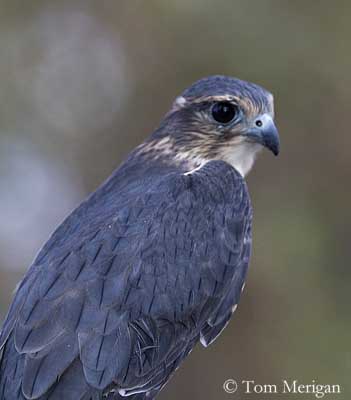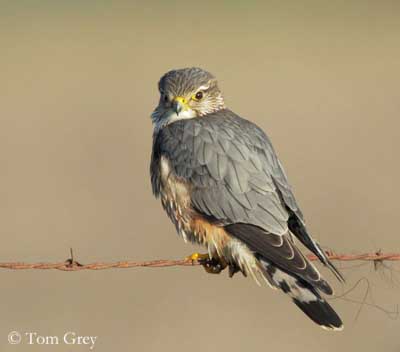
Merlin
Falco columbarius
Falconiforme Order – Falconidae family
BIOMETRICS:
Length: 24-33 cm
Wingspan: 50-67 cm
Weight: M: 150-210 g – F: 190-255 g
DESCRIPTION:
The Merlin is a small, bulky falcon which performs very fast flight.
Adult male has blue-grey upperparts. The upperwing shows darker primary flight feathers and coverts. The grey tail has conspicuous black terminal bar.
On the underparts, breast, belly and undertail-coverts may vary from pale buff to reddish, with whitish streaks. Usually, the dark underparts are heavily streaked, and the pale buff underparts are slightly marked.
The underwing is barred dark grey and white, with reddish tinge across the coverts. The dark grey tail is also barred white.
Fr: Faucon émerillon
All : Merlin
Esp : Esmerejón
Ital : Smeriglio
Nd: Smelleken
Sd: Stenfalk
Photographers:
Aurélien Audevard
OUESSANT DIGISCOPING
Tom Grey
Tom Grey's Bird Pictures
Tom Merigan
Tom Merigan’s Photo Galleries
Bob Moul
Nature Photography
Text by Nicole Bouglouan
Sources:
HANDBOOK OF THE BIRDS OF THE WORLD Vol 2 by Josep del Hoyo-Andrew Elliot-Jordi Sargatal - Lynx Edicions - ISBN: 8487334156
HAWKS, EAGLES AND FALCONS OF NORTH AMERICA by Paul A. Johnsgard - Smithsonian Institution Press - ISBN: 1560989467
GUIDE DES RAPACES DIURNES – Europe, Afrique du Nord et Moyen-Orient de Benny Génsbol – Delachaux et Niestlé – ISBN : 2603013270
BirdLife International (BirdLife International)
Pájaros de España (JL Beamonte)
Wikipedia (Wikipedia, The Free Encyclopedia)

On the head, crown is slate-grey to blue-grey. A white superciliary stripe is above the eye, coming from the forehead. Cheeks, ear-coverts and nape are whitish, washed with pale buff to pale cinnamon, ending into a mottled nuchal band. Chin and throat are white.
The hooked bill is grey with yellow cere. Eyes are dark brown with narrow yellow eye-ring. Legs and feet are yellow.
The female has more brownish upperparts, washed with sandy or rufous tinge. She has grey lower back, rump and uppertail-coverts. The upperwing is more spotted than in male. On the tail, the whitish bands are slightly tinged pale buff.
The underparts are whitish with brownish markings, less contrasted than in male.
The head shows the same pattern but brownish rather than grey.
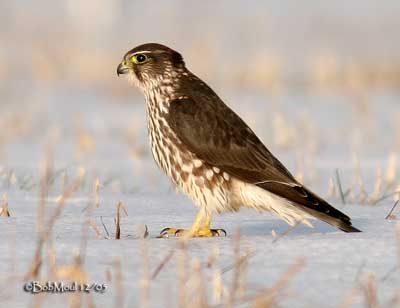
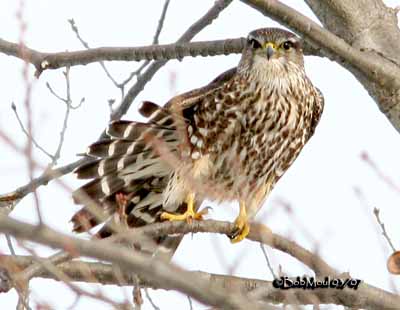
The juvenile is very similar to female, but it has browner and darker upperparts. The underparts are dark sepia to rufous.
The nuchal band is often broader than in adults. The eyes are greyish brown to dark brown. Cere, eye-ring and most parts of the bill are bluish-black. Legs and feet are pale greenish-yellow.
The subadult is similar to adults.
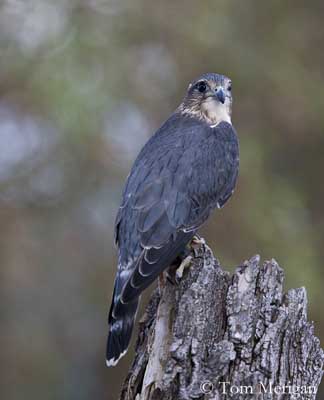
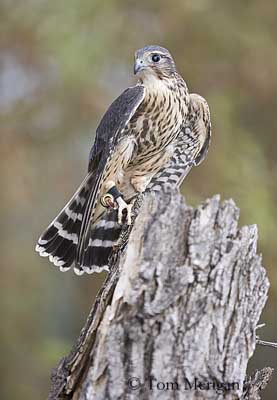
We can find nine subspecies which differ in overall plumage tone.
The males of forested or moist areas have deep blackish-blue upperparts, whereas the birds of the arid steppes have pale greyish-blue upperparts.
There are also some differences in size.
VOICE: SOUNDS BY XENO-CANTO
The Merlin is noisy near the nest and during the displays.
The male’s calls are higher-pitched than those of the female. Both sexes utter four types of vocalizations. First a rapid “ki” or “kek” variable in intensity, speed and rhythm, according to the behaviour. They also give some “tic” or “chip”, alternately repeated by both mates as contact calls when they are separated.
Before to copulate, the male gives a bleating call and the female may also uses it in encounters involving food.
Alarm and advertising calls are shrill “kikikikiki” or “kekekeke”, given by both adults.
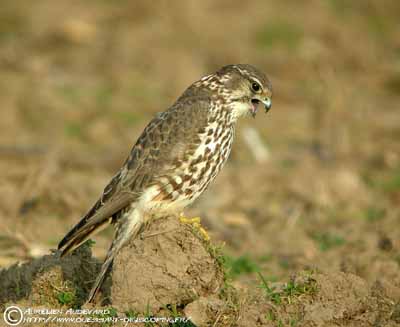
HABITAT:
The Merlin frequents various types of habitats, from sea-level up to tree-line in the mountainous ranges. It can be seen from boreal forest and tundra, to areas with deciduous trees, open prairies and steppes and moorlands, but it prefers the places with some trees and scrubs.
This species breeds in open lands with numerous passerines species.
It winters in marshy areas and steppes with scattered trees. In North America, the wintering habitats are diverse, from deserts to tropical forests.
The immature birds can occur in urban areas.
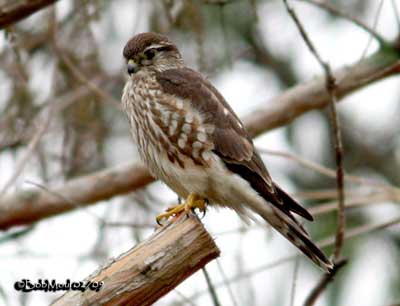
RANGE:
The Merlin breeds in the northern parts of Palaearctic, eastwards in taiga and scrubby tundra of Asia, and in North America.
It migrates southwards over more or less long distance, according to the breeding range.
The Eurasian species move S to Mediterranean, N Africa, Arabian Gulf, Iraq, Iran, China, Japan and Korea.
The North American species move S to Venezuela, Ecuador and N Peru, with some records in NC Brazil and French Guiana.
Some populations in Iceland, British Islands, C Asian Mountains, Pacific NW in N America and locally in Canada, are resident.
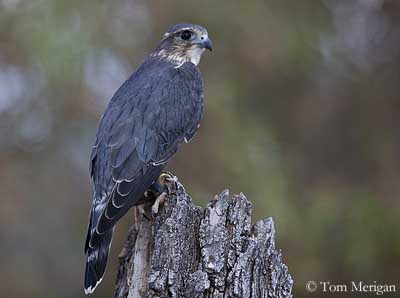
BEHAVIOUR:
The Merlin feeds on small birds (under 50 g) during the breeding season. During the migration, it takes larger preys, bats and insects. The young birds catch mainly rodents and small mammals.
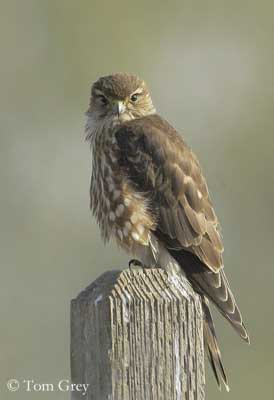
The Merlin hunts from a perch in open area. When the prey is located, it flies low from the ground and swoops down onto it. It also can pursue the prey if the attack fails.
Preys are also caught in mid-air and the falcon performs hard pursuits in flight.
It may hunt with other raptor such as a Sharp-shinned Hawk, or in pairs. The preys are flushed by one bird of prey and caught by the other. The prey is usually killed on the ground or in low flight.
During the breeding season, Merlins perform aerial courtship displays. While the female is on the ground, the male circles above her as for an attack. She crouches with raised tail and calls loudly.
Another display shows the male flying with active wing-beats interspersed with glides and uttering repeated “kik kik kik” before to alight close to the female. Then, copulation occurs, often associated with food exchanges.
The territorial male also performs aerial displays towards rivals, a powerful flight with rapid wing-beats accompanied by rolls. It also can perform dives, rocking glides, fluttering flight and various other aerial figures.
Both sexes also perform high circling and soaring as territorial displays.
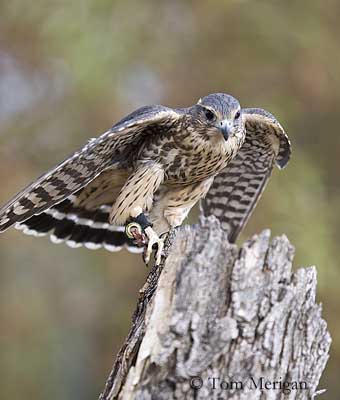
FLIGHT:
As described above, the Merlin is able to perform numerous aerial displays. This falcon is very agile and has direct, fast flight. Wing-beats are very rapid, due to its small size. The flapping-flight is interspersed with glides.
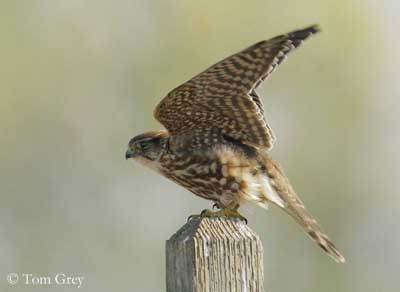
REPRODUCTION:
Breeding season occurs between March and June.
The Merlin is solitary nester. Pairs are formed for one season.
This raptor does not build nest, but it uses old stick nests of Corvids. These nests are situated in trees or tree-cavities, cliff-ledges and even on the ground, a scrape sheltered by dense vegetation, depending on the available sites and according to the range.
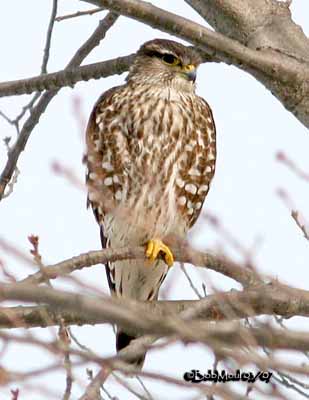
The female lays 3-6 eggs at two days intervals. The incubation lasts about 28 to 32 days shared by both parents, but mainly by female. The male hunts during this period and incubates only about 7/15% of the time.
The chicks are covered in brownish and white down. They are fed by both parents, first by the male, and after one week of brooding, both adults hunt together.
The chicks grow rapidly and fledge 28-32 days after hatching. They are able to fly at this period. They start to catch insects very soon, by the second week after fledging, but they still depend on adults for about five weeks after leaving the nest.
They can breed at one year for the females, and at two years for the males.
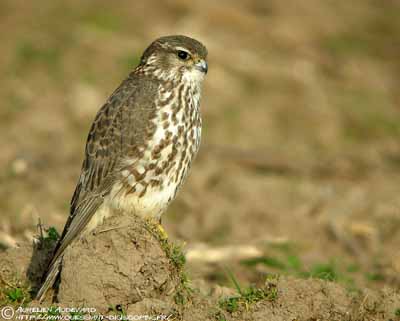
DIET:
The Merlin is a bird-predator, and catches several birds’ species such as small to medium-sized passerines, Horned Larks, and various sparrows, thrushes, warblers, kinglets, vireos and others.
It takes some small mammals such as bats, squirrels, mice and voles, and also reptiles and amphibians such as lizards, snakes and frogs. Large insects are also taken.
It hunts from exposed perches in open areas, and often by flying low from the ground, but it also catches preys in flight.
PROTECTION / THREATS / STATUS:
Currently, the species is not globally threatened, but several threats such as deforestation, persecution, pesticides and human disturbances have involved some declines in the 20th century.
This species has adapted its behaviour to the changes in the habitat, making the populations stable or slightly increasing.
The Merlin is evaluated as Least Concern by Birdlife International.
